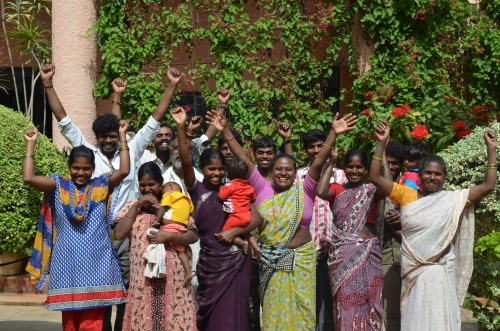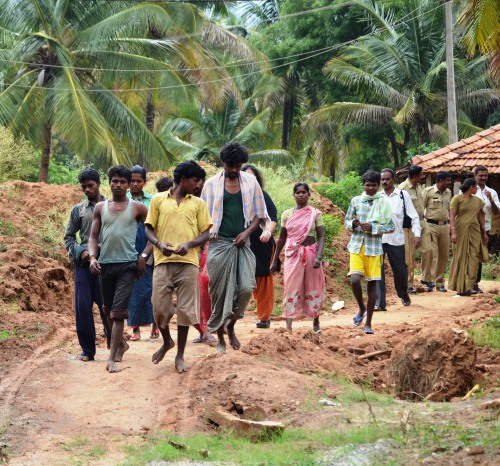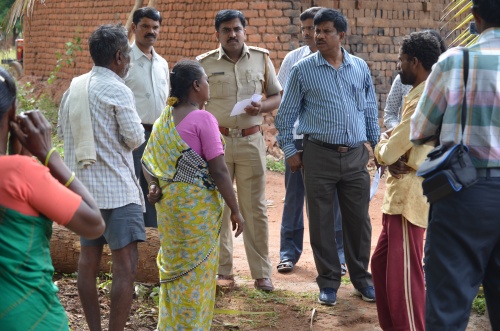When Judgement Day Arrived
On March 10th, 2017, a landmark judgement was pronounced in the NBI Brick Kiln case that dates back to 2014.
Justice was served for thirteen survivors who previously worked as bonded labourers in a brick kiln. The brick kiln owner who had trafficked and abused the victims was found guilty of the bonded labour and trafficking crimes. The judicial decision sentenced the trafficker to ten years of rigorous imprisonment and imposed a penalty of ₹16,000 on him under the IPC 370 (Trafficking of Persons) and Bonded Labour System (Abolition) Act, 1976.
Back in 2010, the brick kiln owner had lured the families on false promises of good wages and a better living. Deceived by the prospect of a better livelihood, the labourers had fallen into the trap of bondage that robbed them of their freedom, including the freedom to make choices about their own lives.
Shivamma and Shivaiah:
Shivaiah, the oldest survivor from the rescue operation conducted at the NBI Brick Kiln has gone through many gruelling experiences. Years later on a sultry afternoon, seated in the very room that they were sheltered in immediately after their rescue, Shivaiah reminisces his bold journey from a victim to a survivor. Seated beside him is Shivamma, his second daughter, a woman of an indomitable spirit.
Hailing from the small, rustic town of Harohalli, a household of five – Shivaiah, his wife and three daughters were a happy family. They had a small house, reared cows and lived a quiet life in their idyllic setting. Their three cows yielded twenty five litres of milk every day that the family sold for a living. The income was not adequate for a family of five and Shivaiah began making bricks at his own house. These bricks were also sold for money. Although, they were not rich, the family managed a simple but a content living.
Since Shivamma dropped out of school just three days of being enrolled at the local school at the age of five and never completed her schooling thereafter, her father send her to sell the milk from the cows in the neighbourhood and sometimes even work in the nearby fields that cultivated wheat. She grew up supporting her family. She was hard working and often toiled on the amber fields of wheat. During the time of harvesting the wheat, the three daughters together would grind the wheat grains on the millstone and extract the flour.
As a child, Shivamma had sowed papaya seeds on the little land around their house – that slowly flowered into a papaya tree that yielded luscious fruits. Coconut trees also grew on their small land. The produce was sold at the local market and the money earned was used to buy food. The family enjoyed delectable non vegetarian food and Shivamma would always look forward to buying meat with the money she earned by selling fruits. When she came of age, Shivamma married her first cousin, Venkatesh. They had children – a daughter and two sons.
Shivaiah found work during the seasonal employment and when labour was required during certain times of the year. He worked on alternate days during the time of seasonal employment. On days where he did not need to work, he took the whole family – now a growing one with son in laws and grandchildren – to watch movies, dramas and traditional theatre forms like Yakshagana. They also loved to visit town fairs and market festivals.
Nanjappa, the perpetrator who had trafficked them into misery and bondage was no stranger to them. Nanjappa lived in the same town and was of the same age as Shivamma. Shivaiah knew Nanjappa since the time he was a young boy and had seen him grow before his own eyes. Shivaiah had always encouraged Nanjappa to study well during his growing years.
After many botched startups, Nanjappa started a new business of brick making. Owing to their acquaintance, Nanjappa coaxed Shivaiah about joining his new business offering him lucrative earnings. Shivaiah and his wife readily agreed to work with Nanjappa. Around this time, Shivaiah had also taken a loan of ₹15,000 from Nanjappa. No sooner had they joined their new ‘job’, Shivamma and her husband also joined them along with their younger son thinking of a better income.
That was the fateful decision that changed the course of their lives dramatically – It was too late when they realized that the lives of three generations of the same family were now entwined in utter bondage with a single decision. A hopeful choice for a better life became the harrowing cause that plummeted their lives into dark ravines of oppression. They were made to work for more than twelve hours every day and forced to make 1000 bricks per day. A family was compensated a meagre amount of ₹1000 a week for their sustenance. Be it heavy rains or the scorching heat, they were not spared from work. If they were unwell, they were not allowed to rest. If they complained, they would be abused. If they tried to flee, they would be thrashed and threatened. They were told they were allowed to leave only upon repayment of the loan they had borrowed. The owner deluded them into believing that their current outstanding amount had escalated to ₹140,000 with the accrued interests. The owner did not allow Shivaiah to even perform the last rites of cremation when his own father died.
On August 13th, 2014, when 13 labourers including Shivaiah’s family was rescued from captivity, they had spent almost five years in uncertainty, confinement and anguish. Worn out by the toil and drained of all hopes of escape, they could not believe that their release by the Anti-Human Trafficking Unit, the District Administration and the local police assisted by International Justice Mission was truly happening!
On March 10th, 2017, the news of the conviction in this case came as an unexpected surprise. They were so filled with emotion. “If Nanjappa yoked us in bondage for five years, then God has recompensed him a double penalty of ten years for his misdeeds!”, said Shivaiah.
Today, they understand that Bonded Labour is a crime and that human beings cannot be held hostages and be coerced to work with little or no pay. Shivaiah regrets the decision that shattered many lives. He says, “My wife and I are old. We would die soon. Our sorrow was (for) our children and we grieved even more about our grandchildren who were thrown into bondage because of my decision. I could not bear to see them deprived of a future.”
Shivamma exclaims, “My son rang up from his village saying that our photos had come in the newspapers. He told us how Nanjappa had been sentenced to ten years in prison for exploiting us. I am happy to see him punished.”
The family now works in different daily wage jobs. Today, they celebrate their freedom. From ‘beings caged birds to mounting on those wings of freedom’, their message to many others who are possibly in bondage at this hour is – “Be bold, stand up for your rights.”
The stories of the survivors that survived the ordeal—the stories of all survivors—are living, breathing reminders of why governments must live up to their responsibility to combat this serious crime in all its forms.
The Trial’s Significance
The verdict is the very first of its kind in Karnataka where a perpetrator has been convicted under IPC 370 for a bonded labour trafficking crime.
A watershed case in the fight against bonded labour and a significant development in the history of the criminal justice system, the ruling in this case has not only doled out dire ramifications to the perpetrator but also proved beyond doubt that justice is possible for the poor.
The dispensation of justice in this case with the shortest possible time has been a remarkable evidence that the doors at the courts of justice would definitely heed to the constant knocks on it!
Courts of Justice: Protecting Human Rights
The Honourable Judge Mohammed Mujahid Ulla of the Additional Sessions Court, Ramangara deemed it significant to extract relevant observations of the Supreme Court of India in his judgement on this case:
*In (1984) 3 Supreme Court Cases 161 Bandhua Mukti Morcha vs Union of India, …it is observed that “They are nonbeings, exiles of Civilization, living a life worse than that of animals, for the animals are at least free to roam about as they like and they can plunder or grab food whenever they are hungry but these outcastes of society are held in bondage, robbed of their freedom and they are consigned to an existence where they have to live either in hovels or under the open sky and be satisfied with whatever little unwholesome food they can manage to get, inadequate though it be to fill their hungry stomachs.”
Notwithstanding its high incidence in Karnataka, yet bonded labour is a well organized crime so abstract and covert in its existence that makes it difficult to trace or detect. The vulnerable become a source of cheap labour and demand driven commodities for scheming opportunists who would not think twice about trampling lives underfoot into deep bondage for their vested interests. Stripped of their dignity of life and labour, these labourers were grossly deprived of an adequate means of livelihood.
*… it is observed that; “Now it is obvious that the poor and the disadvantaged cannot possibly produce relevant material before the court in support of their case and equally where an action is brought on their behalf by a citizen acting pro bone publico, it would be almost impossible for him to gather the relevant material and place it before the Court.”
The Court in this case, weighted heavily the victim testimony, and affirmed that variations in details of testimony are permissible where there is sufficient corroborating evidence of the essence of the case.
*In (1982) 3 Supreme Court Cases 235, People Union for Democratic Rights vs Union of India; “It is obvious that ordinarily no one would willingly supply labour or service to another for less than one’s minimum wage, when he knows that under the law he is entitled to get minimum wage for the labour or service provided by him. It may therefore be legitimately presumed that when a person provides labour or service to another against receipt of remuneration which is less than the minimum wage, he is acting under the force of some compulsion which drives him to work through he is paid less than what he is entitled under law to receive.”
The advance taken by the labourers in times of desperate need underlay conditions precipitating these lives into ruthless bondage. What happens to their lives after bondage? Restoration is a long, arduous journey and the question that arises is whether reparation in any form could really appreciate or compensate the loss and suffering survivors experience and sometimes continue to live with.




